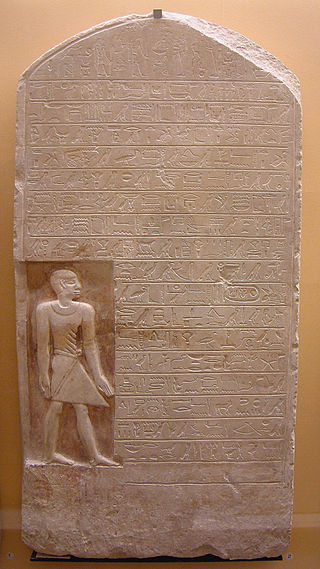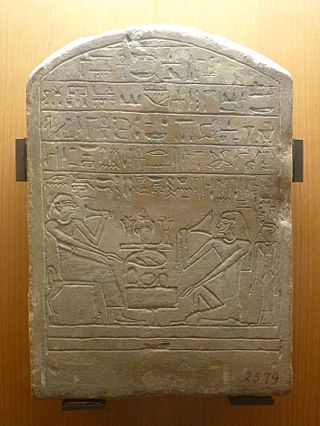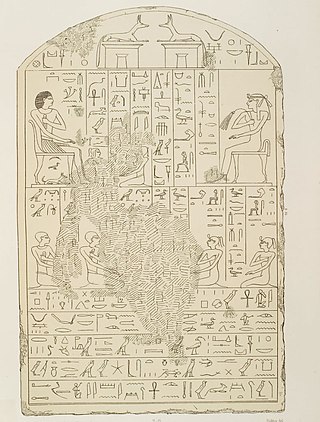Related Research Articles

Amenemhat IV was the seventh and penultimate king of the late Twelfth Dynasty of Egypt during the late Middle Kingdom period. He arguably ruled around 1786–1777 BC for about nine regnal years.

Khasekhemre Neferhotep I was an Egyptian pharaoh of the mid Thirteenth Dynasty ruling in the second half of the 18th century BC during a time referred to as the late Middle Kingdom or early Second Intermediate Period, depending on the scholar. One of the best attested rulers of the 13th Dynasty, Neferhotep I reigned for 11 years.

Sobekhotep III was an Egyptian king of the mid Thirteenth Dynasty of Egypt who reigned three to four years.

Ankhu was an Egyptian vizier during the early 13th Dynasty in the late Middle Kingdom. He is believed to have resided in Thebes in Upper Egypt.

Nubkhaes {nbw-ḫꜥ⸗s} was a queen in ancient Egypt during the Second Intermediate Period. Several of her family members were officials during the late 13th Dynasty. Her name means The Gold [=Hathor] appearsand she held the titles Great Royal Wife and the one united with the beauty of the white crown.

Iymeru Neferkare was the ancient Egyptian vizier under king Sobekhotep IV in the 13th Dynasty, in the Second Intermediate Period.
Khamerernebty I was an ancient Egyptian queen of the 4th dynasty. She was probably a wife of King Khafre and the mother of King Menkaure and Queen Khamerernebty II. It is possible that she was a daughter of Khufu, based on the fact that inscriptions identify her as a King's daughter.
Khamerernebty II was an ancient Egyptian queen of the 4th Dynasty. She was a daughter of Pharaoh Khafre and Queen Khamerernebty I. She married her brother Menkaure and she was the mother of Prince Khuenre.

Senebi was an ancient Egyptian treasurer under the 13th Dynasty kings Neferhotep I and Sobekhotep IV. Senebi belongs to the best attested officials of the 13th Dynasty.
The Papyrus Boulaq 18 is an ancient Egyptian administrative document. It contains an account of the Theban palace dating to the 13th Dynasty. The papyrus lists the palace officials and the rations they received day by day. Important officials mentioned are, for example, the vizier Ankhu, but also the queen Aya. Therefore, the document is of great historical importance. It also reports the journey of the king to the temple at Medamud and reports the arrival of a delegation of Nubians.

Senewosret-Ankh {s-n-wsrt-ꜥnḫ/snfrw} was an ancient Egyptian vizier of the Middle Kingdom, dating to the end of the Twelfth or to the beginning of the Thirteenth Dynasty.

Sobekemsaf(sbk-m-z3=f) was an ancient Egyptian queen of the 17th Dynasty. She was the wife of pharaoh Nubkheperre Intef and sister of an unidentified pharaoh, probably Sekhemre-Heruhirmaat Intef, Sobekemsaf II or Senakhtenre Ahmose.

Mersekhemre Ined was a pharaoh of the late 13th Dynasty, possibly the thirty-fifth king of this dynasty. As such he would have reigned from Memphis over Middle and Upper Egypt for a short time either during the early or mid-17th century, from 1672 until 1669 BC or from 1651 until 1648 BC. He may be the same king as Mersekhemre Neferhotep II.

Menwadjre Sihathor was an ephemeral ruler of the 13th Dynasty during the late Middle Kingdom. Sihathor may never have enjoyed an independent reign, possibly only ruling for a few months as a coregent with his brother Neferhotep I.

Haankhef was the father of the ancient Egyptian kings Neferhotep I, Sihathor, and Sobekhotep IV, who successively ruled Egypt during the second half of the 18th century BC as kings of the 13th Dynasty.
Sobeknakht I was an ancient Egyptian official of the Second Intermediate Period. He was the local governor at Elkab.

Hatshepsut was the name of one or several ancient Egyptian king's daughter(s) of the 13th Dynasty. There are three instances where a person named Hatshepsut is mentioned. It is not known if these items refer to the same or different individuals.
Khakau was the brother of King Sobekhotep III of the Thirteenth Dynasty and part of a powerful family taking power in a time of political turmoil in Upper Egypt. Although not of royal birth, he was given the title of "king's son" by his brother.
Dedusobek Bebi was a high official of the late Thirteenth Dynasty of ancient Egypt. He became the "Great Scribe of the Vizier". This position was directly under the Vizier acting as a deputy.
Hetepti {ḥtp.tj} is a woman holding the title King's Mother and believed to be the mother of king Amenemhat IV, who ruled at the end of the Twelfth Dynasty of the Middle Kingdom in Ancient Egypt.
References
- ↑ A. Gasse V. Rondot: Les inscriptions de Séhel (=Mémoires de l’Institut français d’Archéologie Orientale du Caire 126). Cairo: Institut français d’archéologie orientale. ISBN 9782724704341, pp. 92-93, SEH 162.
- ↑ "Person Queen Snb⸗s-n⸗j | Persons and Names of the Middle Kingdom". pnm.uni-mainz.de.
- ↑ "Berlin ÄM 32630 | Persons and Names of the Middle Kingdom". pnm.uni-mainz.de.
- ↑ "SEH 162 | Persons and Names of the Middle Kingdom". pnm.uni-mainz.de.
- ↑ "Elkab tomb 64 (9) | Persons and Names of the Middle Kingdom". pnm.uni-mainz.de.